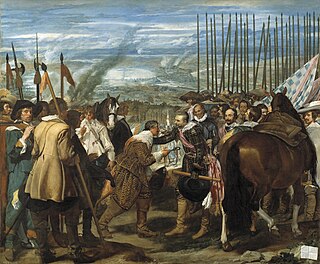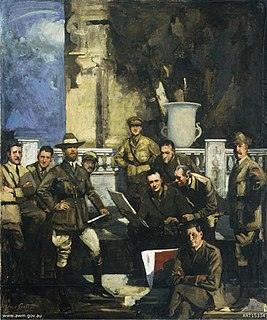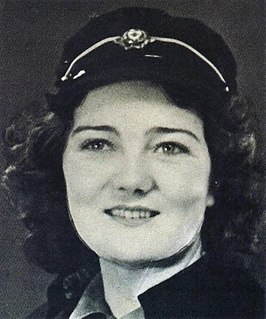
Imperial War Museums (IWM) is a British national museum organisation with branches at five locations in England, three of which are in London. Founded as the Imperial War Museum in 1917, the museum was intended to record the civil and military war effort and sacrifice of Britain and its Empire during the First World War. The museum's remit has since expanded to include all conflicts in which British or Commonwealth forces have been involved since 1914. As of 2012, the museum aims "to provide for, and to encourage, the study and understanding of the history of modern war and 'wartime experience'."

The Australian and New Zealand Army Corps (ANZAC) was a First World War army corps of the Mediterranean Expeditionary Force. It was formed in Egypt in December 1914, and operated during the Gallipoli campaign. General William Birdwood commanded the corps, which primarily consisted of troops from the First Australian Imperial Force and 1st New Zealand Expeditionary Force, although there were also British and Indian units attached at times throughout the campaign. The corps disbanded in 1916, following the Allied evacuation of the Gallipoli peninsula and the formation of I ANZAC Corps and II ANZAC Corps. The corps was reestablished, briefly, in the Second World War during the Battle of Greece in 1941.

Military art is art with a military subject matter, regardless of its style or medium. The battle scene is one of the oldest types of art in developed civilizations, as rulers have always been keen to celebrate their victories and intimidate potential opponents. The depiction of other aspects of warfare, especially the suffering of casualties and civilians, has taken much longer to develop. As well as portraits of military figures, depictions of anonymous soldiers away from the battlefield have been very common; since the introduction of military uniforms such works often concentrate on showing the variety of these.

A war artist is an artist that is either commissioned by a government or publication, or self motivated, to document their first hand experience of war in any form of illustrative or depictive record. War artists explore the visual and sensory dimensions of war, often absent in written histories or other accounts of warfare.

The Museum of New Zealand Te Papa Tongarewa is New Zealand's national museum, located in Wellington. Usually known as Te Papa, it opened in 1998 after the merging of the National Museum of New Zealand and the National Art Gallery. The 17th-most-visited art gallery in the world, an average of more than 1.5 million people visit every year.

Peter McIntyre was a New Zealand painter and author who rose to prominence as a result of artwork produced in his capacity as an official war artist during the Second World War.

Priscilla Muriel McQueen is a poet and three-time winner of the New Zealand Book Award for Poetry.

Brian Lindsay Turner is a New Zealand poet and author. He played hockey for New Zealand in the 1960s; senior cricket in Dunedin and Wellington; and was a veteran road cyclist of note. His mountaineering experience includes an ascent of a number of major peaks including Aoraki / Mount Cook.

Anna Airy was an English oil painter, pastel artist and etcher. She was one of the first women officially commissioned as a war artist and was recognised as one of the leading women artists of her generation.
James Edward Buchanan Boswell was a New Zealand-born British painter, draughtsman and socialist.

Sofia Minson is a contemporary New Zealand oil painter of Māori, Swedish, English and Irish descent.
Herbert James Bowkett Coe was a New Zealand artist, art teacher, industrial designer and early champion of ergonomic design.
The United States Army Art Program or U.S. Army Combat Art Program is a program brought about by the U.S. Army to create artwork documenting its involvements in war and peacetime engagements. The art collection associated with the program is held by the U.S. Army Center of Military History. The United States Army Centre of Military History built the National Museum of the United States Army at Fort Belvoir that is now completed and will open when conditions allow.
British official war artists were a select group of artists who were employed on contract, or commissioned to produce specific works during the First World War, the Second World War and select military actions in the post-war period. Official war artists have been appointed by governments for information or propaganda purposes and to record events on the battlefield; but there are many other types of war artist.
Canadian official war artists create an artistic rendering of war through the media of visual, digital installations, film, poetry, choreography, music, etc., by showing its impact as men and women are shown waiting, preparing, fighting, suffering, celebrating. These traditionally were a select group of artists who were employed on contract, or commissioned to produce specific works during the First World War, the Second World War and select military actions in the post-war period. The four Canadian official war art programs are: the First World War Canadian War Memorials Fund (CWMF), the Second World War Canadian War Records (CWR), the Cold War Canadian Armed Forces Civilian Artists Program (CAFCAP), and the current Canadian Forces Artists Program (CFAP).

Australian official war artists are those who have been expressly employed by either the Australian War Memorial (AWM) or the Army Military History Section. These artist soldiers depicted some aspect of war through art; this might be a pictorial record or it might commemorate how war shapes lives.

Charles Pears was a British painter, illustrator and artist. His work was part of the art competitions at the 1928 Summer Olympics and the 1932 Summer Olympics.
The War Artists Advisory Committee (WAAC), was a British government agency established within the Ministry of Information at the outbreak of the Second World War in 1939 and headed by Sir Kenneth Clark. Its aim was to compile a comprehensive artistic record of Britain throughout the war. This was achieved both by appointing official war artists, on full-time or temporary contracts and by acquiring artworks from other artists. When the committee was dissolved in December 1945 its collection consisted of 5,570 works of art produced by over four hundred artists. This collection was then distributed to museums and institutions in Britain and around the world, with over half of the collection, some 3,000 works, going to the Imperial War Museum.
Elise Constance Mourant was a New Zealand artist. Works by Mourant are held in the collection of the Museum of New Zealand Te Papa Tongarewa.

Mary Evelyn Lentaigne is a British former medical artist and Red Cross Voluntary Aid Detachment nurse who worked at the Queen Victoria Hospital, England, during the Second World War. She is known for the drawings she made there of the surgical procedures of New Zealand plastic surgeon Archibald McIndoe who was working on injured servicemen. Around 300 of her drawings are held by the East Grinstead Museum where they form the Mollie Lentaigne Collection.













